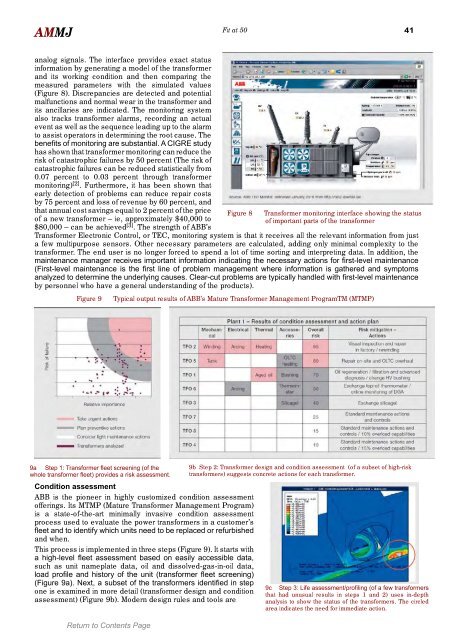April - Library
April - Library
April - Library
You also want an ePaper? Increase the reach of your titles
YUMPU automatically turns print PDFs into web optimized ePapers that Google loves.
AMMJ Fit at 50 41<br />
analog signals. The interface provides exact status<br />
information by generating a model of the transformer<br />
and its working condition and then comparing the<br />
measured parameters with the simulated values<br />
(Figure 8). Discrepancies are detected and potential<br />
malfunctions and normal wear in the transformer and<br />
its ancillaries are indicated. The monitoring system<br />
also tracks transformer alarms, recording an actual<br />
event as well as the sequence leading up to the alarm<br />
to assist operators in determining the root cause. The<br />
benefits of monitoring are substantial. A CIGRE study<br />
has shown that transformer monitoring can reduce the<br />
risk of catastrophic failures by 50 percent (The risk of<br />
catastrophic failures can be reduced statistically from<br />
0.07 percent to 0.03 percent through transformer<br />
monitoring) [2] . Furthermore, it has been shown that<br />
early detection of problems can reduce repair costs<br />
by 75 percent and loss of revenue by 60 percent, and<br />
that annual cost savings equal to 2 percent of the price<br />
of a new transformer – ie, approximately $40,000 to<br />
$80,000 – can be achieved [3] . The strength of ABB’s<br />
Transformer Electronic Control, or TEC, monitoring system is that it receives all the relevant information from just<br />
a few multipurpose sensors. Other necessary parameters are calculated, adding only minimal complexity to the<br />
transformer. The end user is no longer forced to spend a lot of time sorting and interpreting data. In addition, the<br />
maintenance manager receives important information indicating the necessary actions for first-level maintenance<br />
(First-level maintenance is the first line of problem management where information is gathered and symptoms<br />
analyzed to determine the underlying causes. Clear-cut problems are typically handled with first-level maintenance<br />
by personnel who have a general understanding of the products).<br />
Condition assessment<br />
ABB is the pioneer in highly customized condition assessment<br />
offerings. Its MTMP (Mature Transformer Management Program)<br />
is a state-of-the-art minimally invasive condition assessment<br />
process used to evaluate the power transformers in a customer’s<br />
fleet and to identify which units need to be replaced or refurbished<br />
and when.<br />
This process is implemented in three steps (Figure 9). It starts with<br />
a high-level fleet assessment based on easily accessible data,<br />
such as unit nameplate data, oil and dissolved-gas-in-oil data,<br />
load profile and history of the unit (transformer fleet screening)<br />
(Figure 9a). Next, a subset of the transformers identified in step<br />
one is examined in more detail (transformer design and condition<br />
assessment) (Figure 9b). Modern design rules and tools are<br />
Figure 8 Transformer monitoring interface showing the status<br />
of important parts of the transformer<br />
Figure 9 Typical output results of ABB’s Mature Transformer Management ProgramTM (MTMP)<br />
9a Step 1: Transformer fleet screening (of the<br />
whole transformer fleet) provides a risk assessment.<br />
9b Step 2: Transformer design and condition assessment (of a subset of high-risk<br />
transformers) suggests concrete actions for each transformer.<br />
9c Step 3: Life assessment/profiling (of a few transformers<br />
that had unusual results in steps 1 and 2) uses in-depth<br />
analysis to show the status of the transformers. The circled<br />
area indicates the need for immediate action.
















